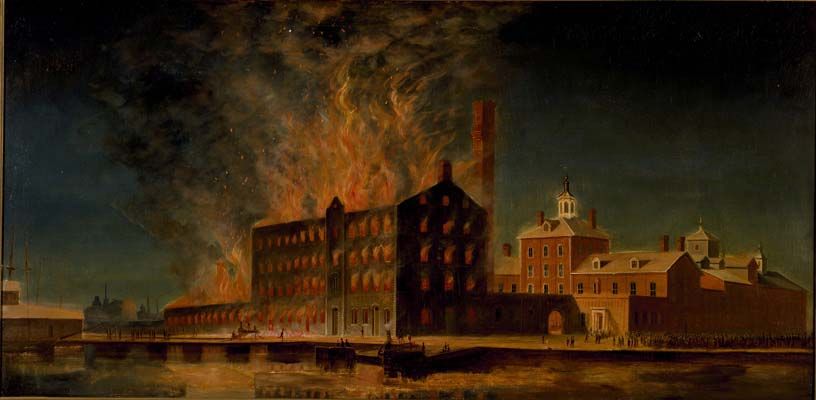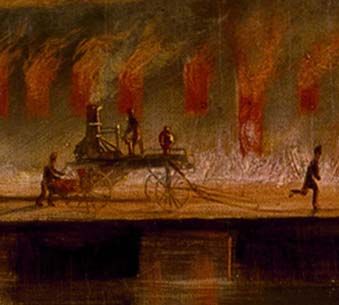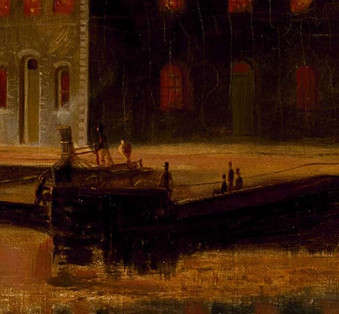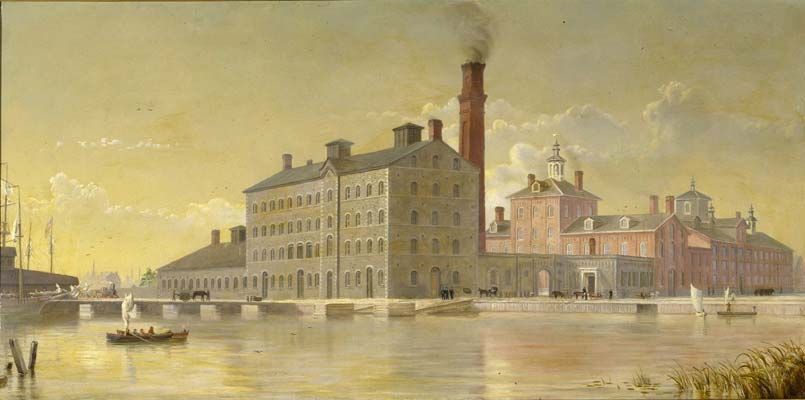 Family Stories
Family Stories
» Show All «Prev «1 ... 12 13 14 15 16 17 18 19 20 ... 44» Next» » Slide Show
1869 Great Fire of ‘69

Crowds stare, firemen pump, and flames rage during the Great Fire of October 26, 1869 G&W
At six o’clock on Tuesday, October 26, 1869 – just as William Gooderham and his family were sitting down for dinner (or “tea”) – a small cask of benzene caught fire and exploded in the fermenting cellar of his 1860 Stone Distillery, precipitating a night of high drama by the Lake. Within minutes, flames were licking the floor, workmen had descended on the spot, and the alarm rang out across the city.
Before long, crowds of people were racing along snow-covered streets toward the scene, guided by the “luminous mass of flames” lighting up the Toronto sky, and throwing a “lurid mantle” over the city. The fire was visible for miles into the countryside, with distant Weston Road being lit better by the distillery fire than the usual gas streetlights.
Within minutes, the City’s two volunteer fire brigades had arrived at the scene and the firemen set to work “with a heartiness, good will and judgment which spoke volumes for their skill and pluck.” They would need both during the long night ahead.

Fire engine tackles the Stone Distillery
While the crowds were gathering and the firemen setting to work at the distillery, all was initially “bustle and activity and terror” at the nearby Gooderham residence. There, family, friends, and servants grabbed furniture and stuffed clothing and valuables into bags and boxes that were loaded onto all manner of conveyances to be carted off to safety. “In the red light of the now furious flames,” the Globe reported,” men, and women, and horses, hurrying to and fro, bearing heavy bundles, rushing here, there, and everywhere, now lost in shadow, now emerging into the light, made up a picture of extraordinary animation and wildness.”
A dozen constables arrived and imposed order, and safety, of hundreds of mesmerized spectators. The firemen stoked their steam engines and started to draw water from the lake. One set of firemen began playing two (pathetically small) streams of water on the great Stone Distillery. The other dragged its hoses toward the vulnerable, but still unignited, buildings to the north – including the new Rectifying Tower with its still, and the Maltings poised above vaults storing large quantities of alcohol. The firefighters poured water over walls and into buildings. Miraculously, their efforts proved successful.
Efforts to save the Stone Distillery were less successful. At first, the flames were confined to the north side of the building, but a strong north wind pushed them southward, right through the building and across the railway tracks, destroying telegraph poles and wires. While a great pile of snow-covered coal and the spars of the schooner Octavia glowed at the G&W wharf, a stream of blue fire poured from the distillery and worked its way along the tracks until, finally, a rough earthwork was thrown across its path and stopped its advance.

Pumping water from Lake Ontario
A series of explosions ripped holes in the building and sent massive stones and timbers flying into the Lake. Meanwhile, the two huge, 12 by 12-foot ventilators at the east and west sides of the roof, dramatically increased the force of the fire inside the building. “The volumes of flame that issued from these were prodigious,” the Globe reported. “Now they dwindled down… and now they sprung up and spread out into immense sheets of fire a hundred feet in height and half as many in breadth.”
By nine o’clock, however, it was clear that the fire would spread no further … but an “immense body of flame still surged inside the building.” Given the nature of the building, great amount of woodwork, immense timbers, and large quantity of grain in the mill, the interior would take hours to be destroyed. Again, the Globe painted a vivid picture:
The massive iron pillars by which the different floors were sustained, placed one above the other with rafters eighteen inches between remained long in their positions, but as the rafters were gradually consumed the pillars toppled down one after the other, adding to the awful ruin within. The iron rods which ran across the building in all directions, supporting the walls snapped and this was a fresh source of anxiety. For when one looked at the lofty walls unsupported within or without, the possibility of their falling was at once suggested. The wall cracked and went in various directions and the top of the east gable was so twisted that every moment it was expected to topple over. Till a late hour, however, the walls still stood.
And continue to stand, they did. In fact, by the next day, it was clear that the great engine that powered the mill and distillery, the mill machinery, and much of the fabric of the building had survived. The devastation was great, but not complete. About $110,000 to $120,000 in damages had been sustained. But no one had been killed or seriously injured.
The mayor and 75 prominent citizens sent a certificate of “hearty sympathy” – but no cash – to the proprietors. Fire Chief James Ashfield thanked Messrs. Gooderham & Worts publicly for the “very handsome sum of Two Hundred Dollars” donated as a mark of their appreciation. And many of the two hundred employees who lost their jobs with the closing down of the distillery, were employed in the frantic efforts to rebuild and reopen the business.
As this final painting indicates, the Stone Distillery was rebuilt along the original lines and reopened about six months later.

Surreal calm at the rebuilt Gooderham & Worts Distillery, May 1, 1870 G&W
Sources consulted include: “Destructive Fire: Burning of Messrs. Gooderham & Worts’ Distillery last night,” The Globe, October 27, 1869, p.1; “The Great Fire: Further Particulars,” The Globe, October 28, 1869; and John Ross Robertson, Landmarks of Toronto, v. 2 (1896), pp. 642-644. The two oil paintings were owned, and probably commissioned, by Gooderham & Worts.
Reprinted with permission from the author, Sally Gibson and from Mathew Rosenblatt, www.distilleryheritage.com
1869 Great Fire of ‘69
At six o’clock on Tuesday, October 26, 1869 – just as William Gooderham and his family were sitting down for dinner (or “tea”) – a small cask of benzene caught fire and exploded in the fermenting cellar of his 1860 Stone Distillery, precipitating a night of high drama by the Lake.
Sally Gibson, The Distillery Archivist tells this tale...
| Owner of original | Reprinted with permission from the author, Sally Gibson and from Mathew Rosenblatt, www.distilleryheritage.com |
| Linked to | The Distillery, Toronto, ON, Canada |
» Show All «Prev «1 ... 12 13 14 15 16 17 18 19 20 ... 44» Next» » Slide Show
